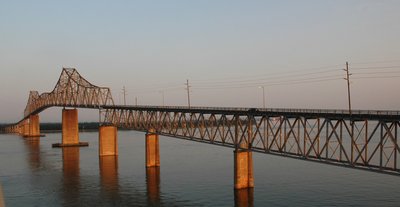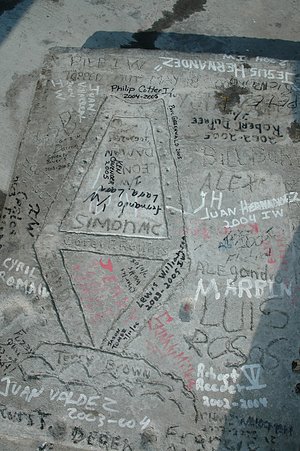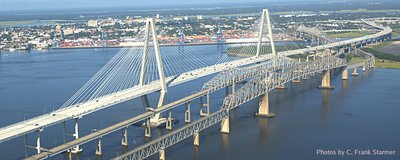The Bridge Blog
A dialog about our new bridge and these web pages
Overview.
Schools and universities are all about learning - and learning is mostlly
brain training. Learning is expedited by repetition and forgetting
is expedited by infrequent use of learned skills or information.
Tracking the building of the Ravenel Bridge and now tracking the
demolition of the Grace and Pearman Bridges bring
many questions to me and help me better understand the role Google
and the Internet play in
just-in-time learning. I enjoy chasing my curiosity and
want to identify ways to encourage younger learners to also enjoy curiosity
chasing and learning.
Many young learners do not understand the importance of repetition. More
important, while experienced learners understand the learning process
they often do not realize the destructive effects of the forgetting
process. Over the course of the
bridge project, I have access to only a few experts.
Rather than a liability, this has become an asset and pushed me to improve
my search skills with Google. Soon, I realized that answers
to questions encountered during my photo adventures were often
only a Google-search away. Gene Stead,
my first boss and I put these ideas together in a small essay:
(see
Restoring the Joy in Learning).
Google + Internet have become dependable extensions of my memory.
Insights I gain from you and this project will find their way into the
learning centers in our schools and universities.
Thu, 21 Jul 2005
July 21, 2005: Transition from building to unbuilding

The construction of the new Cooper River Bridge is complete. The
fireworks and opening ceremony, from my perspective, breathed new
life into our community. Certainly use of the bicycle
and pedestrian walkway during the first days demonstrated both their
utility and the vision of the bridge sponsors.
There is a first chapter and a last chapter with every story and
our bridges are no different. I have started preparations for
keeping our stories alive, now as historical documents. As a
first step, I am moving the Internet address of the Ravenel Bridge story to
http://ravenelbridge.net. This
will provide a stable location and facilitate transition of the site
to a future home, perhaps the Charleston Public Library or the
Historical Society. I have not explored this with any agency, but it
seems to me that our web site (yes, not mine) would be better preserved
under the leadership of a public agency.

Yesterday I started the first chapter of the unbuilding of the
Grace and Pearman bridges. I have moved the Internet address for
our new story to
http://oldcooperriverbridge.org. I shall continue to take
weekly, and in some cases, daily (early morning and late afternoon)
photos of the Charleston approaches, Mt. Pleasant approaches and
the main bridge spans. In addition, I will build a new section
addressing engineering issues and insights, similar to the
Engineering and
Close-ups section I developed around the construction of the
Ravenel bridge.
Many of you have fed me ideas and questions. As we start our new
story, please continue to write me. Let our learning continue!.
posted at: 13:16 | path: | permanent link to this entry
Sat, 16 Jul 2005
July 16, 2005: The meaning of a signature bridge
 Yesterday, Vince Streano, David Wertz and I revisited the top of the
west tower. It was almost 1 year ago (July 21, 2004) that David and
I visited the top of the west tower - at that time looking at a number of
bridge engineering issues. Among them was the cabling process managed
by Olivier Forget from Freyssinet
- and the time was near the end of "le Tour de France". During an
earlier visit to the top of the west tower, I noticed a concrete tablet
on the floor (upper left) with the names of many of the construction
workers. Dumb Frank did not record this photographically at the time. This
time I was not going to repeat the same mistake twice. Not only did I take
several photos of the tablet, but I found Philip Cotter's and Lewis
Williamson's names on the tablet. Philip and Lewis are iron workers, a
very special breed of man that suspended themselves while erecting
edge and floor girders and placing the concrete floor panels. Philip's wife,
Tina, exchanged a number of emails with me about Philip and his
artistic and literary skill - naming the last main-span crane (east side)
the "Last Dinosaur Standing" (see
for the dinosaur story).
Yesterday, Vince Streano, David Wertz and I revisited the top of the
west tower. It was almost 1 year ago (July 21, 2004) that David and
I visited the top of the west tower - at that time looking at a number of
bridge engineering issues. Among them was the cabling process managed
by Olivier Forget from Freyssinet
- and the time was near the end of "le Tour de France". During an
earlier visit to the top of the west tower, I noticed a concrete tablet
on the floor (upper left) with the names of many of the construction
workers. Dumb Frank did not record this photographically at the time. This
time I was not going to repeat the same mistake twice. Not only did I take
several photos of the tablet, but I found Philip Cotter's and Lewis
Williamson's names on the tablet. Philip and Lewis are iron workers, a
very special breed of man that suspended themselves while erecting
edge and floor girders and placing the concrete floor panels. Philip's wife,
Tina, exchanged a number of emails with me about Philip and his
artistic and literary skill - naming the last main-span crane (east side)
the "Last Dinosaur Standing" (see
for the dinosaur story).
Here, permanently placed on the top of the west tower is a symbol of the
worker's bride. Many signatures are absent - but the pride runs all the
way from Bobby Clair through Wade, Peo, Marvin, David and Olivier all the
way to me - as these folks opened doors that enabled me to bring to you
much of the untold stories behind building our Arthur Ravenel Jr. Bridge.
And a final note about the Internet and learning. The Internet provided
me a medium that enabled me to share with you what the bridge folks shared
with me. Not only that, the Internet provided a communication medium that
linked me with Bill Mankin at High Steel, with engineers at the Federal
Highway Administration, Bridge Division, with Buckland and Taylor,
T. Y. Lin, HDR, Freyssinet and Tidewater Skanska. Governor Sanford
and Bob O'Brien even provided input. In the end, Bob has suggested
that I explore transfering
this web site to the Historical Society or the Library -
a wonderful strategy for breathing new life into these pages.
So from me - smiles and a big thank you to all of you!
Frank Starmer, Medical University of South Carolina.
posted at: 13:02 | path: | permanent link to this entry

